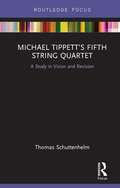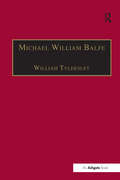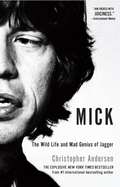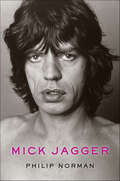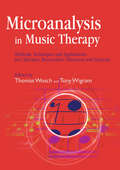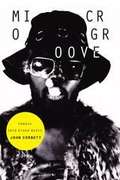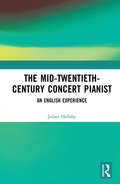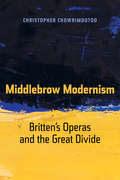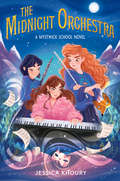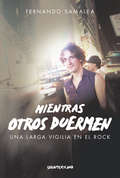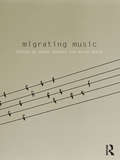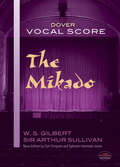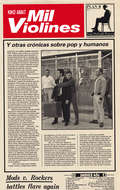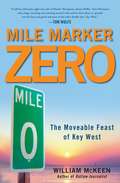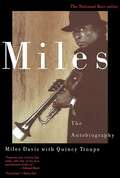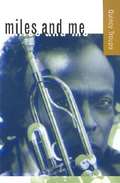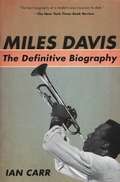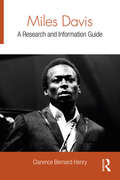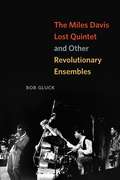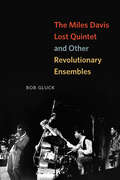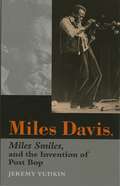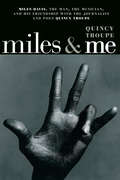- Table View
- List View
Michael Tippett’s Fifth String Quartet: A Study in Vision and Revision
by Thomas SchuttenhelmThomas Schuttenhelm provides a detailed account of the events leading up to and throughout the compositional process associated with Michael Tippett’s Fifth String Quartet and a comprehensive analysis of the entire quartet. The commentary discusses this work in the context of Tippett’s creative development and places it within the historical context of the genre of the string quartet. The commentary includes interviews with the members of the Lindsay String Quartet, who premiered the work, as well as previously unpublished letters from the composer and interviews with Tippett in which he discusses the quartet in detail. Special attention is given to Tippett’s preliminary attempts, which were only recently discovered (2011) and to the evidence that suggests he altered the original ending. Included are images from the composer’s sketchbooks and manuscripts, as well as the original beginning and the altered ending.
Michael William Balfe: His Life and His English Operas (Music In Nineteenth-century Britain Ser.)
by William TyldesleyWithout doubt, Michael William Balfe (1808-1870) was the most successful composer of English opera in the mid nineteenth century. During his lifetime he enjoyed an international reputation and worked with some of the leading singers of the time, including Jenny Lind, Malibran and Grisi. Drawing on previously unused source materials such as letters, legal documents and playbills, this biography of Balfe and in-depth study of his English operas overturns many of the previously accepted 'facts' of the composer's lifestyle. Using London as his base, Dublin-born Balfe spent long periods in Paris and travelled widely in Europe. William Tyldesley discusses the continental influences evident in Balfe's operas and offers new suggestions as to the draw that Paris held for the composer. Far from leading a fairly prosperous and unexceptional life, Balfe is shown to have found himself in financial straits on more than one occasion, and to have employed possibly unethical means of extracting himself from them. Those wishing to perform Balfe's works or to do further research into them, will find Tyldesley's re-examination of the composer a necessary first port of call.
Mick: The Wild Life and Mad Genius of Jagger
by Christopher Andersen“He’s a smart little mother******,I’ll give him that.” —KEITH RICHARDS on MICK JAGGER IS he Jumpin’ Jack Flash? A Street Fighting Man? A Man of Wealth and Taste? All this, it turns out, and far more. By any definition, Mick Jagger is a force of nature, a complete original—and undeniably one of the dominant cultural figures of our time. Swaggering, strutting, sometimes elusive, always spellbinding, he grabbed us by our collective throat a half-century ago and—unlike so many of his gifted peers—never let go. For decades, Mick has jealously guarded his many shocking secrets—until now. As the Rolling Stones mark their 50th anniversary, journalist and #1 New York Times bestselling author Christopher Andersen tears the mask from rock’s most complex and enigmatic icon in a no-holds-barred biography as impossible to ignore as Jagger himself. Based on interviews with friends, family members, fellow music legends, and industry insiders—as well as wives and legions of lovers—MICK sheds new light on a man whose very name defines an era and candidly reveals: —New details about Jagger’s jaw-dropping sexual exploits with more than four thousand women (including Madonna, Angelina Jolie, Carly Simon, Linda Ronstadt, Uma Thurman, and France’s First Lady Carla Bruni)—as well as his encounters with several of rock’s biggest male stars. Also, the day Mick’s wife Jerry Hall and Keith Richards pleaded with Jagger to seek treatment for sex addiction. —The backstage drama surrounding Mick’s knighthood, and Jagger’s little-known ties to Britain’s Royal Family, including Prince William and Kate Middleton. —What he really thinks of today’s superstars—including Lady Gaga, Britney Spears, Beyoncé, Justin Timberlake, Kanye West, and Justin Bieber. —Never-before-revealed, behind-the-scenes accounts of his often turbulent relationships—from his band-mates, ravenous groupies, and rabid fans to such intimates as Andy Warhol, John Lennon, Jackie Onassis, Bill Clinton, and others. —Cocaine, LSD, hashish, and speed—the flabbergasting truth about the extent of Jagger’s substance abuse, and how long it really went on. —A rare glimpse into Mick’s business dealings and the killer instinct that has enabled him to amass a personal fortune well in excess of $400 million. —The stormy “marriage” between Mick and Keith that nearly ran aground over Keith’s searing comments—and all the scandal, mayhem, excess, madness, and genius that went into making the Rolling Stones “the world’s greatest rock-and-roll band.” Like its subject, this book is explosive and riveting—the definitive biography of a living legend who has kept us thrilled, confounded, and astounded. THIS IS MICK.
Mick Jagger
by Philip NormanAuthor Phillip Norman, whose previous bestseller, John Lennon: The Life, was praised as a “haunting, mammoth, terrific piece of work” (New York Times Book Review) and whose classic Shout! is widely considered to be the definitive biography of the Beatles, now turns his attention to the iconic front man of the Rolling Stones, “the greatest rock ’n’ roll band in the world.” Norman’s Mick Jagger is an extraordinarily detailed and vibrantly written in-depth account of the life and half-century-long career of one of the most fascinating and complex superstars of rock music—the most comprehensive biography to date of the famously enigmatic musician. Keith Richards had his say in Life. Now it’s time to get to know intimately the other half of the duo responsible for such enduring hits as “Paint It Black,” “Sympathy for the Devil,” “Gimme Shelter,” and “(I Can’t Get No) Satisfaction.” Mick Jagger is a must read for Stones fans, and everyone who can’t get enough of the serious memoirs and biographies of popular musicians, like Patti Smith’s Just Kids, Does the Noise in My Head Bother You? by Steven Tyler, and the Warren Zevon story, I’ll Sleep When I’m Dead.
Microanalysis in Music Therapy: Methods, Techniques and Applications for Clinicians, Researchers, Educators and Students
by Tony Wigram Barbara L Wheeler Thomas WoschIn the context of music therapy, microanalysis is the detailed analysis of that short period of time during a music therapy session during which some kind of significant change takes place. These moments are crucial to the therapeutic process, and there is increasing interest amongst music therapists in understanding how they come about and whether there are ways of initiating them. The contributors to this groundbreaking book look at methods of micro process analyses used in a variety of music therapy contexts, both clinical and research-based. They outline their methods, which include using video and audio materials, interviewing, and monitoring the client's heart rate, and also give examples of the practical application of microanalysis from their clinical experience, including work with clients who have psychiatric illness, autism and other conditions. Microanalyses in Music Therapy provides a wealth of important theoretical and practical information for music therapy clinicians, educators and students.
Microgroove: Forays into Other Music
by John CorbettMicrogroove continues John Corbett's exploration of diverse musics, with essays, interviews, and musician profiles that focus on jazz, improvised music, contemporary classical, rock, folk, blues, post-punk, and cartoon music. Corbett's approach to writing is as polymorphous as the music, ranging from oral history and journalistic portraiture to deeply engaged cultural critique. Corbett advocates for the relevance of "little" music, which despite its smaller audience is of enormous cultural significance. He writes on musicians as varied as Sun Ra, PJ Harvey, Koko Taylor, Steve Lacy, and Helmut Lachenmann. Among other topics, he discusses recording formats; the relationship between music and visual art, dance, and poetry; and, with Terri Kapsalis, the role of female orgasm sounds in contemporary popular music. Above all, Corbett privileges the importance of improvisation; he insists on the need to pay close attention to "other" music and celebrates its ability to open up pathways to new ideas, fresh modes of expression, and unforeseen ways of knowing.
Microtonality and the Tuning Systems of Erv Wilson: Mapping the Harmonic Spectrum (Routledge Studies in Music Theory)
by Terumi NarushimaThis book explores the emerging area of microtonality through an examination of the tuning theories of Erv Wilson. It is the first publication to offer a broad discussion of this influential theorist whose innovations have far-reaching ramifications for microtonal tuning systems. This study addresses the breadth and complexity of Wilson’s work by focusing on his microtonal keyboard designs as a means to investigate his tuning concepts and their practical applications. Narushima examines materials ranging from historical and experimental tunings to instrument design, as well as musical applications of mathematical theories and multidimensional geometry. The volume provides an analysis of some of Wilson’s most significant theoretical ideas, including the Scale Tree, Moments of Symmetry, Constant Structures, and Combination-Product Sets. These theories offer ways to conceptualize musical scales as patterns with structural integrity and whose shapes can be altered to produce infinitely varying forms. The book shows how these structural properties can be used to map scales onto a microtonal keyboard by providing step-by-step guidelines and clearly illustrated examples. Most importantly, it brings together theoretical and practical methods of tuning to enable composers, performers, and instrument designers to explore previously uncharted areas of microtonality, making a significant contribution to the fields of music theory, composition and music technology.
The Mid-Twentieth-Century Concert Pianist: An English Experience
by Julian HellabyIn this book, Julian Hellaby presents a detailed study of English piano playing and career management as it was in the middle years of the twentieth century. Making regular comparisons with early twenty-first-century practice, the author examines career-launching mechanisms, such as auditions and competitions, and investigates available means of career sustenance, including artist management, publicity outlets, recital and concerto work, broadcasts, recordings and media reviews. Additionally, Hellaby considers whether a mid-twentieth-century school of English piano playing may be identified and, if so, whether it has lasted into the early decades of the twenty-first century. The author concludes with an appraisal of the state of English pianism in recent years and raises questions about its future. Drawing on extensive research from a wide variety of primary and secondary sources, this book is structured around case-studies of six pianists who were commencing and then developing their careers between approximately 1935 and 1970. The professional lives and playing styles of Malcolm Binns, Peter Katin, Moura Lympany, Denis Matthews, Valerie Tryon and David Wilde are examined, and telling comparisons are made between the state of affairs then and that of more recent times. Engagingly written, the book is likely to appeal to professional and amateur pianists, piano teachers, undergraduate and postgraduate music students, academics and anyone with an interest in the history of pianists, piano performance and music performance history in general.
Middlebrow Modernism: Britten’s Operas and the Great Divide (California Studies in 20th-Century Music #24)
by Christopher ChowrimootooAt publication date, a free ebook version of this title will be available through Luminos, University of California Press’s Open Access publishing program. Visit www.luminosoa.org to learn more. Situated at the intersections of twentieth-century music history, historiography, and aesthetics, Middlebrow Modernism uses Benjamin Britten’s operas to illustrate the ways in which composers, critics, and audiences mediated the “great divide” between modernism and mass culture. Reviving mid-century discussions of the middlebrow, Christopher Chowrimootoo demonstrates how Britten’s works allowed audiences to have their modernist cake and eat it: to revel in the pleasures of consonance, lyricism, and theatrical spectacle even while enjoying the prestige that came from rejecting them. By focusing on moments when reigning aesthetic oppositions and hierarchies threatened to collapse, this study offers a powerful model for recovering shades of grey in the traditionally black-and-white historiographies of twentieth-century music.
The Midnight Orchestra (A Mystwick School Novel)
by Jessica KhouryIn this spellbinding sequel to The Mystwick School of Musicraft, Amelia must master the magic of Composing to help her school win a magic competition—and save her friends from a mysterious evil.Things are finally looking up for Amelia Jones: she's officially a Mystwick student, and she even has a teacher to help her learn how to use her rare Composing magic. When Mystwick enters an international magic competition, it’s Amelia's chance to Compose something that will help them win the day.The only problem is that she still doesn’t understand how her powers work. But then she hears about a super exclusive Midnight Orchestra—half performance, half magical black market—and Amelia is sure that’s where she’ll find the answer to her Composing problem.But the Midnight Orchestra is far more sinister than it initially appears and if Amelia can’t unlock her Composing powers, not only will Mystwick lose the musicraft competition, she won’t be able to rescue her friends from the danger unleashed in this thrilling adventure.
Mientras otros duermen: Una larga vigilia en el rock
by Fernando SamaleaContinuación del exitoso Qué es un long play, en este segundo volumen de memorias Fernando Samalea, el baterista del rock argentino, explora cronológicamente, con humor y emoción, historias musicales entre 1997 y 2010. Fernando Samalea homenajea a sus compañeros de ruta con las anécdotas que los unieron: García en su incendiario período Say No More; Joaquín Sabina cuando gestaba 19 días y 500 noches, y Gustavo Cerati, a quien acompañó en sus giras Ahí vamos y Fuerza natural. En estudios, escenarios, aviones y bares de todo el mundo, los músicos de varias generaciones, estéticas y búsquedas -Fabi Cantilo, A-Tirador Láser, Caetano Veloso, Joan Manuel Serrat, Calle 13, Fernando Kabusacki...- protagonizan la novela mayor que cuenta la historia privada del rock argentino y la de la música en castellano. «Siempre me sorprendió la musicalidad de Fernando. No piensa como un baterista, no tiene vicios musicales, ni de los demás. Su primer libro me divirtió mucho. ¡Tiene más memoria que yo! Le deseo mucho éxito como escritor. Es el primer escritor-baterista que conozco.»Charly García, 2016 «Más allá de que lo admiro profundamente, se me reveló como una persona que irradia un optimismo tan contagioso como vital. Siempre tiene alguna historia para contarte, internándose sin prejuicios en mundos nuevos y haciendo amigos por doquier. A pura luz y bohemia, Sama propaga el hedonismo romántico que lo ha mantenido casi inalterable a lo largo de estos años. Es un privilegio ser su compañero de ruta y su amigo.»Gustavo Cerati, 2007
Migrating Music (CRESC)
by Jason Toynbee Byron DueckMigrating Music considers the issues around music and cosmopolitanism in new ways. Whilst much of the existing literature on ‘world music’ questions the apparently world-disclosing nature of this genre – but says relatively little about migration and mobility – diaspora studies have much to say about the latter, yet little about the significance of music. In this context, this book affirms the centrality of music as a mode of translation and cosmopolitan mediation, whilst also pointing out the complexity of the processes at stake within it. Migrating music, it argues, represents perhaps the most salient mode of performance of otherness to mutual others, and as such its significance in socio-cultural change rivals – and even exceeds – literature, film, and other language and image-based cultural forms. This book will serve as a valuable reference tool for undergraduate and postgraduate students with research interests in cultural studies, sociology of culture, music, globalization, migration, and human geography.
The Mikado Vocal Score (Dover Opera Scores)
by W. S. Gilbert Sir Arthur SullivanAn enduringly popular romantic spoof that has charmed countless listeners since its 1885 debut, The Mikado's appealing Japanese setting lends fresh novelty to Sullivan's winsome melodies and Gilbert's satirical verses.This new vocal score edition by Carl Simpson and Ephraim Hammett Jones includes all the voice parts, a piano reduction of the full score, and the complete libretto. This inexpensive edition exactly matches the excellent full score of The Mikado, also published by Dover, and prepared by the same editorial team. It will be indispensable to soloists, chorus members, and rehearsal pianists.
Mil violines y otras crónicas sobre pop y humanos
by Kiko AmatEste es un libro sobre música pop. Todo aquel que no sea fan de ésta entra aquí por su cuenta y riesgo Un paseo del autor por las canciones de su vida. Las canciones son el eje alrededor del cual gira todo, y el nexo de unión entre las diversas historias (ficticias o no) que se cuentan. El libro no pretende ser ensayístico ni autobiográfico en cada uno de los caminos que va tomando, así que el autor puede permitirse incorporar narrativa, diálogos, listas, y lo que se le vaya ocurriendo graciosamente. También tienen cabida situaciones cotidianas. Estas pueden ser similares en tono y contenido a la serie de columnas que al autor realizó para La Vanguardia y Catorcephenia. Es decir, basarse en la misma línea temática: la relación del autor y sus canciones con otra persona, en este caso su mujer, que aparecería regularmente en cada capítulo, incluso situando la acción en el momento deescribir el libro.
Mil violines y otras crónicas sobre pop y humanos
by Kiko AmatLas canciones son el eje alrededor del cual gira todo, y el nexo de unión entre las diversas historias (ficticias o no) que se cuentan. El libro no pretende ser ensayístico ni autobiográfico en cada uno de los caminos que va tomando, así que el autor puede permitirse incorporar narrativa, diálogos, listas, y lo que se le vaya ocurriendo graciosamente. También tienen cabida situaciones cotidianas. Estas pueden ser similares en tono y contenido a la serie de columnas que al autor realizó para La Vanguardia y Catorcephenia. Es decir, basarse en la misma línea temática: la relación del autor y sus canciones con otra persona, en este caso su mujer, que aparecería regularmente en cada capítulo, incluso situando la acción en el momento de escribir el libro.
Mile Marker Zero: The Moveable Feast of Key West
by William MckeenTrue tales of writers and pirates, painters and potheads, guitar pickers and drug merchants in America's southernmost city For Hemingway and Fitzgerald, there was Paris in the twenties. For others, later, there was Greenwich Village, Big Sur, and Woodstock. But for an even later generation--one defined by the likes of Jimmy Buffett, Tom McGuane, and Hunter S. Thompson--there was another moveable feast: Key West, Florida. The small town on the two-by-four-mile island has long been an artistic haven, a wild refuge for people of all persuasions, and the inspirational home for a league of great American writers. Some of the artists went there to be literary he-men. Some went to re-create themselves. Others just went to disappear--and succeeded. No matter what inspired the trip, Key West in the seventies was the right place at the right time, where and when an astonishing collection of artists wove a web of creative inspiration.Mile Marker Zero tells the story of how these writers and artists found their identities in Key West and maintained their friendships over the decades, despite oceans of booze and boatloads of pot, through serial marriages and sexual escapades, in that dangerous paradise.Unlike the "Lost Generation" of Paris in the twenties, we have a generation that invented, reinvented, and found itself at the unending cocktail party at the end--and the beginning--of America's highway.
Miles: The Autobiography
by Miles Davis Quincy TroupeFor more than forty years Miles Davis has been in the front rank of American music. Universally acclaimed as a musical genius, Miles is one of the most important and influential musicians in the world. The subject of several biographies, now Miles speaks out himself about his extraordinary life. Miles: The Autobiography,like Miles himself, holds nothing back. For the first time Miles talks about his five-year silence. He speaks frankly and openly about his drug problem and how he overcame it. He condemns the racism he has encountered in the music business and in American society generally. And he discusses the women in his life. But above all, Miles talks about music and musicians, including the legends he has played with over the years: Bird, Dizzy, Monk, Trane, Mingus, and many others. The man who has given us some of the most exciting music of the past few decades has now given us a compelling and fascinating autobiography, featuring a concise discography and thirty-two pages of photographs.
Miles and Me
by Quincy TroupeQuincy Troupe's candid account of his friendship with Miles Davis is a revealing portrait of a great musician and an intimate study of a unique relationship. It is also an engrossing chronicle of the author's own development, both artistic and personal. As Davis's collaborator on Miles: The Autobiography, Troupe--one of the major poets to emerge from the 1960s--had exceptional access to the musician. This memoir goes beyond the life portrayed in the autobiography to describe in detail the processes of Davis's spectacular creativity and the joys and difficulties his passionate, contradictory temperament posed to the men's friendship. It shows how Miles Davis, both as a black man and an artist, influenced not only Quincy Troupe but whole generations. Troupe has written that Miles Davis was "irascible, contemptuous, brutally honest, ill-tempered when things didn't go his way, complex, fair-minded, humble, kind and a son-of-a-bitch." The author's love and appreciation for Davis make him a keen, though not uncritical, observer. He captures and conveys the power of the musician's presence, the mesmerizing force of his personality, and the restless energy that lay at the root of his creativity. He also shows Davis's lighter side: cooking, prowling the streets of Manhattan, painting, riding his horse at his Malibu home. Troupe discusses Davis's musical output, situating his albums in the context of the times--both political and musical--out of which they emerged.
Miles Davis: The Definitive Biography
by Ian CarrThis exhaustively researched, revised edition of Ian Carr's classic biography throws new light on Davis' life and career: from the early days in New York with Charlie Parker; to the Birth of Cool; through his drug addiction in the early 1950s and the years of extraordinary achievements (1954-1960), during which he signed with Columbia and collaborated with such unequaled talents as John Coltrane, Bill Evans, Wynton Kelly and Cannonball Adderly. Carr also explores Davis' dark, reclusive period (1975-1980), offering firsthand accounts of his descent into addiction, as well as his dramatic return to life and music. Carr has talked with the people who knew Miles and his music best including Bill Evans, Joe Zawinul, Keith Jarrett, and Jack DeJohnette, and has conducted interviews with Ron Carter, Max Roach, John Scofield and others.
Miles Davis (Impact Biographies)
by George R. Crisp Franklin WattsPeople whose power, influence, or perseverance have changed the world are the subjects of these candid biographies, which stress the impact of these individuals on the course of 20th-century events. Each book includes a bibliography and an index. Trumpeter, bandleader, and composer Miles Davis greatly influenced the course of jazz from the late 1940s until his death in 1991. He used his thoughtful, economical trumpet style to forge a stunning variety of new sounds. This frank, mesmerizing biography takes the reader inside the dazzling world of Miles Davis: his relationships with other jazz masters, his impact on jazz styles and innovations; and his recurrent health and drug problems.
Miles Davis: A Research and Information Guide (Routledge Music Bibliographies)
by Clarence Bernard HenryThis research and information guide provides a wide range of scholarship on the life, career, and musical legacy of Miles Davis, and is compiled for an interdisciplinary audience of scholars in jazz and popular music, musicology, and cultural studies. It serves as an excellent tool for librarians, researchers, and scholars sorting through the massive amount of material in the field.
The Miles Davis Lost Quintet and Other Revolutionary Ensembles
by Bob GluckMiles Davis's Bitches Brew is one of the most iconic albums in American music, the preeminent landmark and fertile seedbed of jazz-fusion. Fans have been fortunate in the past few years to gain access to Davis's live recordings from this time, when he was working with an ensemble that has come to be known as the Lost Quintet. In this book, jazz historian and musician Bob Gluck explores the performances of this revolutionary group--Davis's first electric band--to illuminate the thinking of one of our rarest geniuses and, by extension, the extraordinary transition in American music that he and his fellow players ushered in. Gluck listens deeply to the uneasy tension between this group's driving rhythmic groove and the sonic and structural openness, surprise, and experimentation they were always pushing toward. There he hears--and outlines--a fascinating web of musical interconnection that brings Davis's funk-inflected sensibilities into conversation with the avant-garde worlds that players like Ornette Coleman and John Coltrane were developing. Going on to analyze the little-known experimental groups Circle and the Revolutionary Ensemble, Gluck traces deep resonances across a commercial gap between the celebrity Miles Davis and his less famous but profoundly innovative peers. The result is a deeply attuned look at a pivotal moment when once-disparate worlds of American music came together in explosively creative combinations.
The Miles Davis Lost Quintet and Other Revolutionary Ensembles
by Bob GluckMiles Davis’s Bitches Brew is one of the most iconic albums in American music, the preeminent landmark and fertile seedbed of jazz-fusion. Fans have been fortunate in the past few years to gain access to Davis’s live recordings from this time, when he was working with an ensemble that has come to be known as the Lost Quintet. In this book, jazz historian and musician Bob Gluck explores the performances of this revolutionary group—Davis’s first electric band—to illuminate the thinking of one of our rarest geniuses and, by extension, the extraordinary transition in American music that he and his fellow players ushered in. Gluck listens deeply to the uneasy tension between this group’s driving rhythmic groove and the sonic and structural openness, surprise, and experimentation they were always pushing toward. There he hears—and outlines—a fascinating web of musical interconnection that brings Davis’s funk-inflected sensibilities into conversation with the avant-garde worlds that players like Ornette Coleman and John Coltrane were developing. Going on to analyze the little-known experimental groups Circle and the Revolutionary Ensemble, Gluck traces deep resonances across a commercial gap between the celebrity Miles Davis and his less famous but profoundly innovative peers. The result is a deeply attuned look at a pivotal moment when once-disparate worlds of American music came together in explosively creative combinations.
Miles Davis, Miles Smiles, and the Invention of Post Bop
by Jeremy YudkinFocusing on one of the legendary musicians in jazz, this book examines Miles Davis's often overlooked music of the mid-1960s with a close examination of the evolution of a new style: post bop. Jeremy Yudkin traces Davis's life and work during a period when the trumpeter was struggling with personal and musical challenges only to emerge once again as the artistic leader of his generation.A major force in post-war American jazz, Miles Davis was a pioneer of cool jazz, hard bop, and modal jazz in a variety of small group formats. The formation in the mid-1960s of the Second Quintet with Wayne Shorter, Herbie Hancock, Ron Carter, and Tony Williams was vital to the invention of the new post bop style. Yudkin illustrates and precisely defines this style with an analysis of the 1966 classic Miles Smiles.
Miles & Me: Miles Davis, the man, the musician, and his friendship with the journalist and poet Quincy Troupe
by Quincy TroupeAn intimate story of Miles Davis, the man, the musician, and his friendship with the young journalist and poet Quincy Troupe--soon to be a major motion picture.Poet, activist and journalist Quincy Troupe's candid account of his friendship with Miles Davis is a revealing portrait of a great musician and an engrossing chronicle of the author's own artistic and personal growth. Miles and Me describes in intimate detail the sometimes harrowing processes of Davis's spectacular creativity and the joys and travails Davis's passionate and contradictory temperament posed to the two men's friendship. Miles and Me shows how Miles Davis, both as an artist and as a black man, influenced Troupe and whole generations of Americans while forever changing the face of jazz.In 1985, Spin magazine hired Troupe to do an exclusive two-part interview with the by-then legendary jazz artist Davis. The hour-and-a-half scheduled interview stretched to ten hours. After it was published, Davis was so enamored of Troupe and the interview that he finally relented to a major publisher's request that he write his autobiography under the condition that they could get Quincy Troupe to write it. Miles: The Autobiography became an instant bestseller and opened up the entire field of popular music autobiography. Years later, Quincy went back to his notes of his time with Miles that had been so important to them both, and produced this more intimate book, Miles and Me, told from his side of their friendship. Miles and Me takes us from St. Louis, where both men grew up, to New York, where both men lived, to Malibu where Miles also kept a home. Troupe also takes us through the entire catalogue of Davis's recordings. Troupe calls his friend "irascible, contemptuous, brutally honest, ill-tempered when things didn't go his way, complex, fair-minded, humble, kind, and a son-of-a-bitch." The author's love and appreciation infuses Miles and Me with a rare quality of grace, and at the same time, throughout the book, Troupe's observations of his friend are keen, sometimes hilariously funny, and truthful, as he knows Miles would want him to be.
